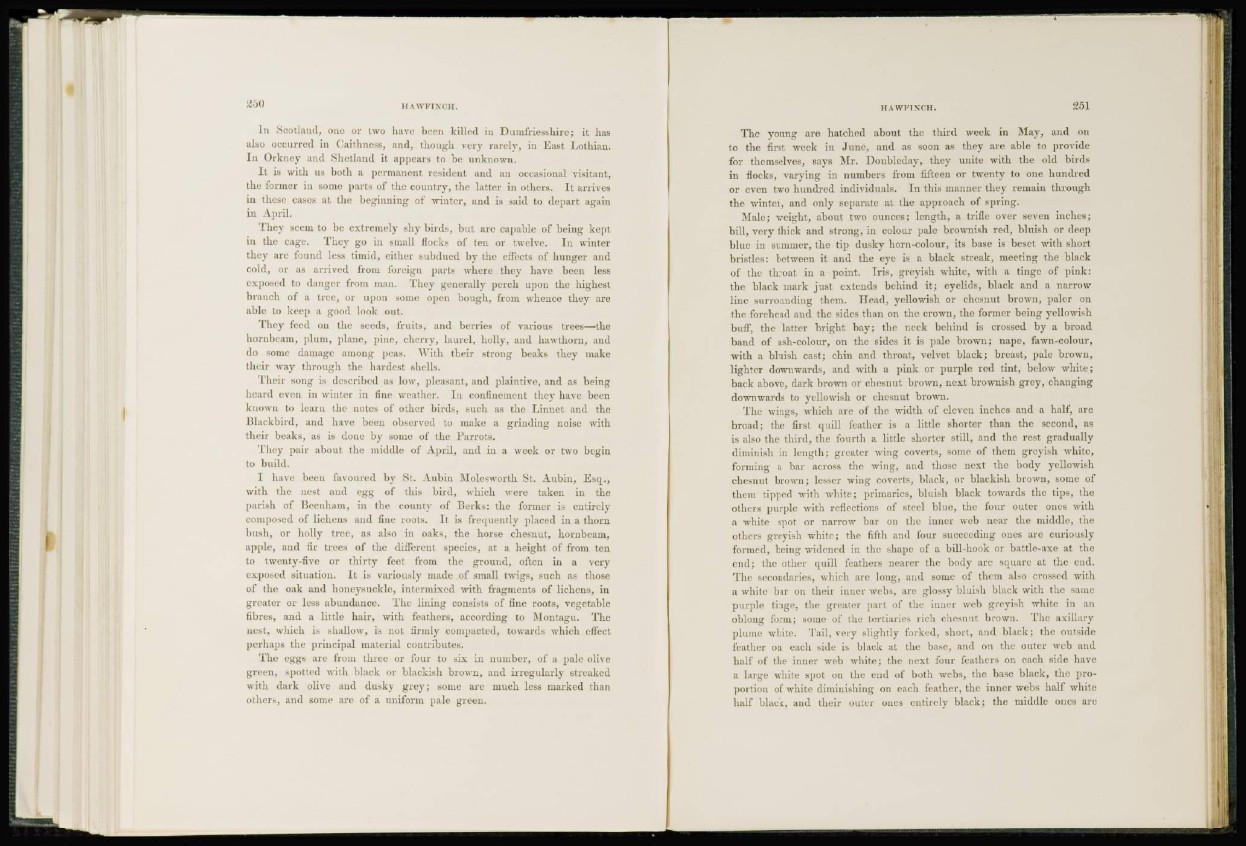
In Scotland, one or two have been killed in Dumfriesshire; it has
also occurred in Caithness, and, though very rarely, in East Lothian.
In Orkney and Shetland it appears to he unknown.
It is with us hoth a permanent resident and an occasional visitant,
the former in some parts of the country, the latter in others. It arrives
in these cases at the beginning of winter, and is said to depart again
in April.
They seem to be extremely shy birds, but arc capable of being kept
in the cage. They go in small Hock's of ten or twelve. In winter
they arc found less timid, either subdued by the effects of hunger and
cold, or as arrived from foreign parts where they have been less
exposed to danger from man. They generally perch upon the highest
branch of a tree, or upon some open bough, from whence they are
able to keep a good look out.
They feed on the seeds, fruits, and berries of various trees—the
hornbeam, plum, plane, pine, cherry, laurel, holly, and hawthorn, and
do some damage among peas. With their strong beaks they make
their way through the hardest shells.
Their song is described as low, pleasant, and plaintive, and as being
heard even in winter in fine weather. In confinement they have been
known to learn the notes of other birds, such as the Linnet and the
Blackbird, and have been observed to make a grinding noise with
their beaks, as is done by sonic of the Parrots.
They pair about the middle of April, and in a week or two begin
to build.
I have been favoured by St. Aubin Molesworth St. Aubin, Esq.,
with the nest and egg uf this bird, which were taken in the
parish of Becnham, in the county of Berks: the former is entirely
composed of lichens and fine roots. It is frequently placed in a thorn
bush, or holly tree, as also in oaks, the horse chesnut, hornbeam,
apple, and fir trees of the different species, at a height of from ten
to twenty-five or thirty feet from the ground, often in a very
exposed situation. It is variously made of small twigs, such as those
of the oak and honeysuckle, intermixed with fragments of lichens, in
greater or less abundance. The lining consists of fine roots, vegetable
fibres, and a little hair, with feathers, according to Montagu. The
nest, which is shallow, is not firmly compacted, towards which effect
perhaps the principal material contributes.
The eggs arc from three ur four to six in number, of a pale olive
green, spotted with black or blackish brown, and irregularly streaked
with dark olive and dusky grey; sonic are much less marked than
others, and some arc of a uniform pale green.
The young are hatched about the third week in May, and on
to the first week in June, and as soon as they are able to provide
for themselves, says Mr. Doubleday, they unite with the old birds
in flocks, varying in numbers from fifteen or twenty to one hundred
or even two hundred individuals. In this manner they remain through
the winter, and only separate at the approach of spring.
Male; weight, about two ounces; length, a trifle over seven inches;
bill, very thick and strong, in colour pale brownish red, bluish or deep
blue in summer, the tip dusky horn-colour, its base is beset with short
bristles: between it and the eye is a black streak, meeting the black
of the throat in a point. Iris, greyish white, with a tinge of pink:
the black mark just extends behind it; eyelids, black and a narrow
line surrounding them. Head, yellowish or chesnut brown, paler on
the forehead and the sides than on the crown, the former being yellowish
buff, the latter bright bay; the neck behind is crossed by a broad
band of ash-colour, on the sides it is pale brown; nape, fawn-colour,
with a bluish cast; chin and throat, velvet black; breast, pale brown,
lighter downwards, and with a pink or purple red tint, below while;
back above, dark brown or chesnut brown, next brownish grey, changing
downwards to yellowish or chesnut brown.
The wings, which arc of the width of eleven inches and a half, are
broad; the first quill feather is a little shorter than the second, as
is also the third, the fourth a little shorter still, and the rest gradually
diminish in length; greater wing coverts, some of them greyish white,
forming a bar across the wing, and those next the body yellowish
chesnut brown; lesser wing coverts, black, o r blackish brown, s o n i c of
them tipped with white; primaries, bluish black towards the tips, the
others purple with reflections of steel blue, the four outer ones with
a white spot or narrow bar on the inner web near the middle, the
others greyish white; the fifth and four succeeding ones are curiously
formed, being widened in the shape of a bill-hook or battle-axe at the
end; the other quill feathers nearer the body arc square at the end.
The secondaries, which are long, and some of them also crossed with
a white bar on their inner webs, are glossy bluish black with the same
purple tinge, the greater part of the inuer web greyish white in an
oblong form; some of the tertiaries rich chesnut brown. The axillary
plume white. Tail, very slightly forked, short, and black; the outside
feather on each side is black at the base, and on the outer web and
half of the inner web white; the next four feathers on each side have
a large white spot on the end o f both webs, the base black, the proportion
of white diminishing on each feather, the inner webs half white
half black, and their outer ones entirely black; the middle ones are